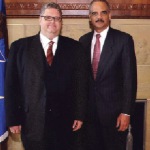
By Gale Courey Toensing, Indian Country Today Media Network
The statistics are horrifying: 34 percent of American Indian and Alaska Native women will be raped in their lifetimes and 39 percent will be subjected to domestic violence; on some reservations, Native women are murdered at more than 10 times the national average; over 85 percent of Natives who are victims of rape or sexual assault describe their offenders as non-Indian. Under the current law, tribal courts have no jurisdiction to prosecute non-Indian perpetrators of felony violence against Native women, and U.S. attorneys decline 67 percent of the cases referred to them.
And yet in the waning days of the 112th Congress, Republican leaders in the House thwarted the reauthorization of the Violence Against Women Act (VAWA), killing off an 18-year-old piece of legislation that included provisions that would help decrease the epidemic of violence against Native women on Indian land. The Republicans specifically opposed provisions of a Senate version of the bill passed last April that would recognize concurrent tribal jurisdiction over non-Indians who commit violent crimes against women on Indian lands, but a House bill passed in May dropped the provision and the two bills could not be reconciled during the lame-duck session of the 112th Congress. Some Republicans claim that expanding tribal jurisdiction is unconstitutional.
But M. Brent Leonhard, a deputy attorney general for the Confederated Tribes of the Umatilla Indian Reservation in Oregon, says nine early treaties, some of them signed by the Founding Fathers, acknowledge the inherent sovereign right of tribes to exercise jurisdiction over non-Indians in Indian country and set a precedent for extending tribal jurisdiction in the VAWA. Leonhard explored these treaties and three famous related U.S. Supreme Court Indian law cases in the article “Closing a Gap in Indian Country Justice,” published in the Harvard Law School Journal on Racial and Ethnic Justice in October 2012.
The cases are Oliphant v. Suquamish Indian Tribe, Duro v. Reina and United States v. Lara, and together they provide a clear illustration of the complexity of Indian law. In Oliphant the Supreme Court ruled that tribal courts do not have inherent jurisdiction to try and punish non-Indians and may not assume such jurisdiction unless specifically authorized to do so by Congress. In Duro the justices decided that tribal governments could not prosecute Indians who were members of other tribes for crimes committed on their reservations. That didn’t go over well with the tribes and in response, Congress provided a “Duro fix” by amending a section of the Indian Civil Rights Act that specifically authorized tribes to prosecute non-member Indians as an exercise of their inherent sovereign power. The Duro fix was challenged in the Lara case, in which a majority of the justices essentially upheld it. But, says Leonhard, “it is precarious to rely solely on the Court’s holding in Lara” to support the legality of what would essentially be an “Oliphant fix”—acknowledging the tribal power to prosecute non-Indians as an exercise of their inherent sovereign power as opposed to an exercise of congressionally delegated federal power. That’s why the treaties are important.
Leonhard says he wrote “Closing a Gap in Indian Country Justice” because he had been involved in drafting the VAWA reauthorization legislation and in particular the language regarding tribal jurisdiction over non- Indians for domestic violence offences. “And certainly one of the issues that I knew would come up, which everyone knew would come up, is whether or not there’s a constitutional bar in light of Oliphant and Lara,” Leonhard says. “So I did a fair bit of research and analysis on that. I went through all the ratified treaties I could find, looking at how they dealt with criminal jurisdiction issues, and those nine treaties, the very early treaties, make it very clear that the Founding Fathers allowed tribes to exercise jurisdiction over non-Indians at least when those non-Indians were residing in Indian country.”
The treaties, Leonhard says, can be used to bolster the efforts already under way to pass VAWA in the 113th Congress. “I hope it provides more ammunition to their arguments,” he says. “If all the opponents are left with is, ‘There’s no constitutional basis to do this,’ then they don’t really have an argument.”
One of the treaties Leonhard examined is the Treaty of Fort McIntosh. In early January 1785, the Confederation Congress sent three commissioners to Fort McIntosh in Ohio country to negotiate a treaty with the Delaware, Wyandot, Ottawa and Chippewa Indians. The Indian representatives were young leaders with no authority to negotiate a treaty, and according to one report, the Americans plied the young Indian warriors with alcohol and after weeks of negotiations, 13 Indians signed the Treaty of Fort McIntosh on January 21, 1785.
The treaty was a very good deal for the Americans. The Indians agreed to live under the U.S. government’s “protection” and promised not to form alliances with any “other sovereign whatsoever.” They gave up vast stretches of their land in southern and eastern Ohio, acknowledged that it now belonged to the United States and promised not to settle on any part of it. The U.S. dictated that the Indians would be confined to the western corner of modern day Ohio. The Indians accepted that the U.S. would keep army posts at strategic points and they agreed to hand over to the United States any Indian who robbed or murdered “any citizen of the United States” (Indians weren’t U.S. citizens until 1924).
But there was one provision in the treaty that respected the Indians’ inherent sovereignty: Article 5 affirmed their right to punish U.S. citizens and other non-Indians who tried to settle on Indian land. “If any citizen of the United States, or other person not being an Indian, shall attempt to settle on any of the lands allotted to the Wiandot and Delaware nations in this treaty…such person shall forfeit the protection of the United States, and the Indians may punish him as they please.”
Leonhard says that provision affirms inherent tribal sovereignty, “because it talks in terms of removing federal protections over non-Indians, and if that’s removed what remains is the tribal jurisdiction. It doesn’t talk in terms of granting federal power to tribes to prosecute non-Indians or delegated authority. So I think the authority that ends up in those cases is inherent authority.”
In “Closing a Gap,” Leonhard cites two long-standing principles that apply when interpreting Indian treaties. The first is that Indian treaties, “by their nature, reserved rights that tribal nations already had—they were a grant from Indians to the United States, not a grant of rights to Indians from the United States.” The second is that treaties are to be interpreted liberally in favor of the tribes and if there is any question about the appropriate interpretation “it must be read in a way that does not prejudice tribes.”
Leonhard’s paper also cites the first treaty entered into by the United States—the 1778 treaty with the Delaware Indians—which is even more explicit on the nation-to-nation relationship between the newly formed United States and the ancient Delaware Indian nation. “For the better security of the peace and friendship now entered into by the contracting parties, against all infractions of the same by the citizens of either party…neither party shall proceed to the infliction of punishment on the citizens of the other, otherwise than by securing the offender or offenders by imprisonment…till a fair and impartial trial can be had by judges or juries of both parties, as near as can be to the laws, customs and usages of the contracting parties and natural justice: The mode of such trials to be hereafter fixed by the wise men of the United States in Congress assembled, with the assistance of such deputies of the Delaware nation, as may be appointed to act in concert with them in adjusting this matter to their mutual liking. And it is further agreed between the parties aforesaid, that neither shall entertain or give countenance to the enemies of the other, or protect in their respective states, criminal fugitives, servants or slaves but the same to apprehend, and secure and deliver to the State or States, to which such enemies, criminals, servant or slaves respectively belong.”
This first treaty with an Indian nation shows that the U.S. “viewed tribes not just as having inherent power to punish citizens of the United States for crimes committed against the tribe”—a power that the tribe agreed in the treaty to share concurrently with the U.S. government—“but that the powers exercised by Indian nations were essentially the same as the powers exercised by the United States—they were equals as nations,” Leonhard says.
Six of the nine treaties that recognized the ability of tribes to punish non-Indians on Indian land were ratified between 1785 and 1789 by the Confederation Congress, a legislative body that included of 33 of the men who signed the Constitution. So, if the Founding Fathers acknowledged the inherent sovereignty of tribes to exercise jurisdiction over non-Indians on Indian land in treaties that have been around for more than 200 years, why do some legislators today question the constitutionality of expanded tribal jurisdiction?
“I’m not sure that the representatives in Congress are really aware of [these treaties],” Leonhard says. “I’m not sure it would change their opinion ultimately, but I think it’s a serious hurdle that they have to address if they’re going to claim that there’s a constitutional bar.”
John Dossett, general counsel of the National Congress of American Indians (NCAI), applauds Leonhard’s work. “I think the treaties are very strong and some of these arguments are very viable,” he says. The NCAI, a member of the National Task Force to End Sexual and Domestic Violence Against Women, has been a strong advocate for the VAWA, compiling talking points and fact sheets on a VAWA to counter the misinformation about expanded tribal jurisdiction website. Dossett agrees that constitutional federal Indian law is not something members of Congress are likely to know about “so we really have to educate folks, and that has been happening. I think we’re not far away from getting [VAWA] done. There’s a lot of support on both sides of the aisle, and that’s good news.”
Six years have passed since the 2007 publication of Amnesty International’s report: “Maze of Injustice: The failure to protect indigenous women from sexual violence in the U.S.A.”: “Indigenous Peoples in the U.S.A. face deeply entrenched marginalization—the result of a long history of systemic and pervasive abuse and persecution,” the report says. “Sexual violence against indigenous women today is informed and conditioned by this legacy of widespread and egregious human rights abuses. It has been compounded by the federal government’s steady erosion of tribal government authority and its chronic under-resourcing of those law enforcement agencies and service providers [that] should protect indigenous women from sexual violence. It is against this backdrop that American Indian and Alaska Native women continue to experience high levels of sexual violence, a systemic failure to punish those responsible and official indifference to their rights to dignity, security and justice.”
Native women are vulnerable to violent attacks by non-Indians who know they are untouchable by the “maze of injustice” that allows them to victimize women with impunity. Passage of the VAWA expanded tribal jurisdiction would allow tribes to hold these offenders accountable, Leonhard says. The essential question, he says, is whether or not Congress can pass a VAWA that expands inherent tribal authority. It did in Lara and I think conservative Republicans are saying now, well, we’ve got a different Supreme Court, and it’s not at all clear a majority would agree with that outcome, which may be true,” Leonhard says. “But, regardless, you’ve got these early treaties by the Founding Fathers. A conservative approach to interpreting the Constitution—like [Justice Antonin] Scalia’s originalism—is you look at what the original intent of the Founding Fathers was with regard to those provisions in the Constitution, and when you do that and you see they already ratified nine treaties that expanded the inherent powers of tribes to include the authority over non-Indians, it’s just a given that there’s no constitutional bar to passing the VAWA.”
***
Treaties
Brent Leonhard has found numerous treaties between the United States and tribal nations that explicitly recognize the power of tribes to exercise criminal jurisdiction over non-Indian citizens of the United States. These treaties refute the claim that there is a “constitutional bar” against restoring tribal jurisdiction over criminal acts of violence against women committed in Indian country. All of the treaties can be found in Indian Affairs: Laws and Treaties, Compiled and Edited by Charles J. Kappler, here.
Treaty with the Delaware Indians, Sept. 17, 1778. In the first peace treaty signed with the Indian nations, the United States shows the U.S. “viewed tribes not just as having the inherent power to punish citizens of the United States for crimes committed against the tribe, but that the powers exercised by Indian nations were essentially the same as the powers exercised by the United States—they were equals as nations.”
Treaty with the Six Nations, Oct. 22, 1784. This treaty recognizes that the nations exercised at least some form of de facto jurisdiction over non-Indians as an aspect of their inherent sovereign powers and contains no language suggesting that the six nations gave up any inherent sovereign power to exercise jurisdiction of any type over U.S. citizens in the future.
Treaty with the Wyandot, Delaware, Chippewa, and Ottawa nations, January 21, 1785. This treaty explicitly agrees that any non-Indian who tries to settle on Indian land will “forfeit the protection of the United States” and may be punished by the Indians and that any Indians who commit crimes against the U.S. will be turned over to be punished by U.S. laws, implying that in the absence of such agreements, tribal nations could refuse to do so.
Treaty with the Cherokee, Nov. 28, 1785. This treaty is similar to the Wyandot treaty with some changes: The U.S. agreed that any of its citizens attempting to settle on Cherokee lands– including those already settled there who did not leave within six months of the signing of the treaty–would be subject to the criminal jurisdiction of the tribal nation. The Cherokee agreed to deliver to the U.S. Indians or non Indians who committed certain crimes against provided the punishment was the same as it would have been if committed by a U.S. and the U.S. agreed that any punishment of an Indian would be witnessed by the Cherokees if they so desired.
Treaty with the Choctaw, Jan. 3, 1786, Treaty with the Chickasaw, Jan. 10, 1786, Treaty with the Shawnee, Jan. 31, 1786, Treaty with the Wyandot, Jan. 8, 1789, Treaty with the Creeks, Aug. 7, 1790, and Treaty with the Cherokee, July 2, 1791, are all similar to the 1785 Wyandot Treaty.
Treaty with the Wyandots, Delewares, Shawanoes, Ottawas, Chipewas, Putawatimes, Miamis, Eel-river, Weea’s, Kickapoos, Piankashaws, and Kaskaskias, Aug. 3, 1795. This treaty expands the earlier Wyandot Treat to include language reflecting the 1790 Indian Trade and Nonintercourse Act requiring congressional approval for the transfer of Indian land. “If any citizen of the United States, or any other white person or persons, shall presume to settle upon the lands now relinquished by the United States, such citizen or other person shall be out of the protection of the United States; and the Indian tribe, on whose land the settlement shall be made, may drive off the settler, or punish him in such manner as they shall think fit; and because such settlements made without the consent of the United States, will be injurious to them as well as to the Indians, the United States shall be at liberty to break them up, and remove and punish the settlers as they shall think proper, and so effect that protection of the Indian lands herein before stipulated.”
Read more at http://indiancountrytodaymedianetwork.com/2013/02/07/early-treaties-prove-us-founding-fathers-would-have-deemed-vawa-constitutional-147534










